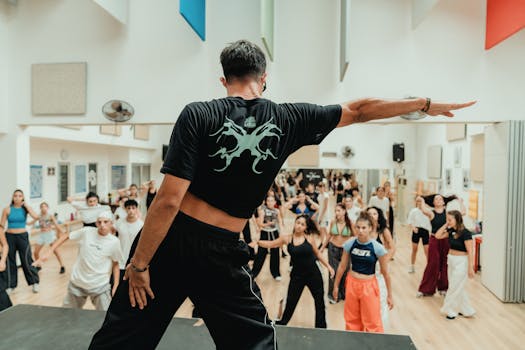Annonces
Dance is an expressive art form that has captivated audiences for centuries. Yet, in recent years, it has evolved into a data-driven endeavor. Dance analytics has emerged, where data collection and analysis enhance performance and promote growth within the dance community.
Incorporating technology into dance allows dancers, choreographers, and organizations to gain insights into performance metrics. By understanding dance analytics, the development of artists becomes intentional and impactful.
This article explores the multifaceted world of dance analytics, its significance, methods of implementation, and its influence on both artists and audiences. Interested in the intersection of art and data? Dive into the details below.
What is Dance Analytics?
Dance analytics refers to the systematic use of data to analyze various aspects of performance. These include movement patterns, audience engagement, and artist development. By employing data-driven techniques, organizations can seize opportunities for improvement.
This specialized field combines artistic creativity with quantitative research. It deals with understanding dancers’ movements, enhancing choreography, and evaluating shows’ success. As a result, it provides crucial insights for continuous advancement.
Annonces
Moreover, dance analytics helps in tracking progress over time, enabling dancers and choreographers to set precise goals. This leads to enhanced creative output and improved technical abilities.
In addition, utilizing technology allows for real-time feedback. This helps dancers adjust their techniques and practices, promoting sustained growth and higher performance quality.
Ultimately, dance analytics serves as a bridge between artistry and empirical evidence. By understanding its potential, we can better navigate this dynamic landscape.
Annonces
The Importance of Dance Analytics
Understanding the importance of dance analytics can assist artists in refining their practice. Insights generated from data allow artists to harness their strengths and work on weaknesses.
Additionally, analytics grant a deeper understanding of audience preferences. This information can significantly enhance programming decisions, ensuring performances resonate with viewers.
Moreover, organizations can streamline operations using data collected on ticket sales and engagement. This ultimately leads to improved financial planning and resource allocation.
In educational environments, dance analytics offers insights into student progress. Instructors can tailor their approaches to meet individual student needs, enhancing learning outcomes.
As art continues to evolve, staying informed about analytics becomes essential. It empowers dancers and choreographers, fostering a culture of growth and adaptability within the artistic community.
Methods of Collecting Dance Data
The methods used for collecting dance data can vary. Common techniques include wearable technology, video analysis, and audience surveys. Each method serves a unique purpose in contributing to comprehensive analytics.
Wearable technology, such as motion sensors, captures movement data in real-time. This enables precise tracking of techniques, stamina, and performance quality throughout training sessions.
Video analysis allows for a detailed breakdown of choreography. By reviewing recorded performances, dancers can identify areas that require attention and improvement.
Finally, audience surveys provide essential feedback on perceptions and engagement levels. Understanding viewer responses allows organizations to refine their performances, catering more effectively to audience interests.
By combining these data collection methods, dance professionals can gather rich insights. This comprehensive approach supports informed decision-making tailored to both the artists and their audience.
The Role of Technology in Dance Analytics
Technology plays a vital role in modern dance analytics. Innovations such as artificial intelligence and machine learning are revolutionizing how data is collected and interpreted.
Advanced software can analyze movement patterns, providing dancers with immediate feedback. This technology allows for faster adjustments and improvements in technique.
Furthermore, platforms have emerged that connect dancers with analytics tools, streamlining the workflow. Such solutions make it easier to gather, analyze, and apply insights effectively.
Additionally, virtual reality has entered the dance realm, offering immersive training experiences. These environments enhance performance research by simulating various conditions and audience reactions.
As technology advances, its integration into dance analytics will continue to evolve. This promises even greater precision and insights into the dance community.
Case Studies in Dance Analytics
Case studies provide valuable examples of successful dance analytics applications. One notable instance is the Royal Ballet, which utilizes data to analyze dancer performance and audience engagement.
Using wearable sensors, the ballet tracks movement efficiency, ballet technique, and stamina. The findings inform training regimens and choreography, increasing overall performance quality.
Another case is the Alvin Ailey American Dance Theater, renowned for its data-driven marketing strategies. By surveying audiences, they identify programming preferences, resulting in highly attended performances.
The Chicago Dancing Festival showcases how dance analytics can enhance festival programming. By analyzing audience data, they curate shows that align with ticket sales, ensuring captivating performances.
Through these case studies, it is clear that tangible benefits arise from data-driven approaches. Artists and organizations can greatly enhance their impact on audiences and artists alike.
Challenges in Implementing Dance Analytics
Despite its advantages, implementing dance analytics does come with challenges. One significant hurdle is the accessibility of data collection technologies among smaller dance organizations.
Moreover, ethical considerations arise when using audience data for marketing purposes. Striking a balance between personalization and privacy is essential to maintaining audience trust.
Additionally, not all dancers may be receptive to data-driven approaches. Resistance to technology or fear of data interpretation can create barriers to effectively adopting analytics.
Furthermore, the learning curve associated with new technologies can impede adoption. Dancers and organizations may require training to fully benefit from dance analytics.
Addressing these challenges is crucial for fostering a culture of data-driven growth in the dance community. Collaborative efforts can create supportive environments for embracing analytics.
The Future of Dance Analytics
The future of dance analytics looks promising, with technology continually evolving. Emerging trends suggest more integration of artificial intelligence for personalized training experiences.
Moreover, the continued development of virtual and augmented reality is likely to enhance performance assessments. This innovation opens new avenues for immersive experiences and data visualization.
Customizable analytics platforms that cater to the needs of individual dance styles will also emerge. Such tools will allow for tailored insights, fostering growth for various genres.
Furthermore, collaboration among dance organizations, educators, and technologists will yield innovative strategies for data usage. This collaboration could refine best practices in dance education and performance.
In conclusion, as the dance landscape shifts, so will the role of analytics. Those engaged in the dance community must embrace these tools to enhance artistry and foster growth.
Conclusion
Understanding dance analytics is essential for artists and organizations alike. This data-driven approach enriches dance practices, audience engagement, and organizational efficiencies, fostering growth in the community.
By harnessing the power of technology, dance professionals can gain insights that propel them forward. Continuous innovation promises to shape the future of dance analytics in exciting ways.
As we navigate the balance between artistry and data, maintaining human connection remains key. Ultimately, the fusion of these elements can lead to profound advancements in dance.
Embracing dance analytics not only benefits individuals but also enriches the entire artistic landscape. Thus, it is imperative to stay informed and engaged in this exciting evolution.



